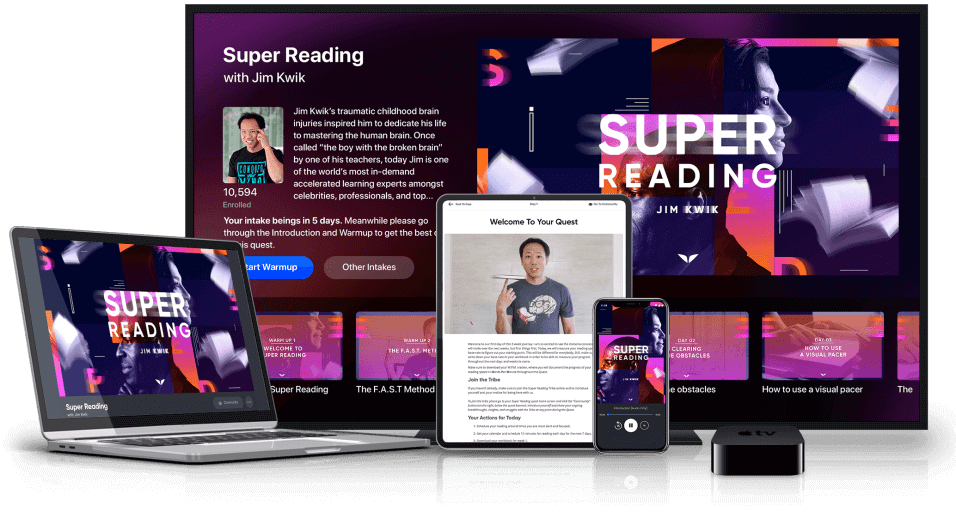I never thought I would find a decent speed-reading course.
I thought I’d just need to create my own as part of Hardcore University.
And then I found Mind Valley’s Super Reading 3-Week Video Course and I was blown away.
Now I don’t need to create my own speed-reading course, because Jim Kwik and MindValley have created the course I wanted to see in the world – so I will just review and promote them.
Mind Valley’s Super Reading course does not sacrifice comprehension for speed.
This was the main problem I had with most speed-reading courses – there’s only one gear.
A good speed-reading course should not be all about speed. Speed is simply one tool, a high gear shift, to unlock other reading strategies. And Mind Valley’s Super Reading gets this so right.
My results with Mind Valley’s Super Reading
In just a couple of days, I doubled my words per minute (WPM) to 540 and understood everything I read – and my speed is still getting faster every day.
Mind Valley’s Super Reading is also, quite simply, A LOT of fun.
Super Reading is supposed to take around 3 weeks, with daily video lessons, each one building on the previous lesson, and with homework to keep you progressing.
You can do the course faster and still see results, but perseverance and commitment to the technique over the long-term will likely yield the best results.
My ultimate goal is to be able to reach 1,000 words per minute with 90% comprehension as I believe this is what my literary hero Harold Bloom could achieve. Actually, he likely read much faster than that and was, in his own words, a “freak”.
My reading speed goal also takes another goal into account – I want to be able to read more slowly too.
The great thing about ramping up your reading speed is that when you come to slow down, your baseline level of “slow” reading is faster than most reader’s fast reading.
Week 1 of Mind Valley’s Super Reading
The first day will have you finding your starting speed, prescribing you do the exercises for 15 x mins per day, with an aim of achieving 3 x your normal reading speed.
You’ll want a plot-driven book at first, something fun to read, hardback, with characters, conflict, and story.
This is for practice before moving to more technical reading.
You are not reading stale standardised test-like texts. You choose the things you’re most interested in and passionate about.
On the first day, you’ll immediately become acquainted with how to measure your words per minute (WPM).
I read 63 lines of Oscar Wilde ‘The Truth of Masks’ in 2 mins, which is 32 lines per minute, and with 10 words per line on average (counting based on 3 lines, divided by 3), we get this formula:
Lines per min x words per line = words per minute
So mine was: 32 x 10 = 320 words per minute (WPM)
Your WPM will change depending on how tired you are, the difficulty level of what you’re reading, and a much more background information, so numbers vary.
I’m a big boy when it comes to reading, and my personal preference is literary works that are “over my head”, so I think a starting speed of 320 WPM for a Wilde essay talking about Shakespeare is pretty good.
I haven’t measured my speed when it comes to more commercial fiction, but I do remember when I used to read Young Adult I could inhale a book in around an hour or so.
Once you’ve got the hang of measuring WPM speeds, the second day has Jim Kwik teaching you a technique to boost reading speed by 25-75%.
Can you imagine boosting an investment that much?
Indeed, reading is a great investment.
What you’re doing at the start of the course is focusing on training speed.
Obviously there are two parts to reading:
- speed
- comprehension
You can’t have one without the other, but you also can’t train both at the same time (it’s like losing fat and gaining muscle), so we need to isolate them.
After Jim goes through the technique for boosting your reading speed by up to 75% using what’s called a visual pacer, he then gets into an interesting discussion on the 3 main obstacles to effective reading.
One of those obstacles is simply that we have been taught to be slow readers.
If you feel like a slow reader, which would be around 200 WPM, you were trained to read that way. It’s simply a matter of training and better education to correct that.
By the time I reached the third day of the course (which I compressed into one day on a long lockdown weekend), I was still using Oscar Wilde’s work (Dorian Gray is wonderful) and had increased my reading speed 40% to reach 450 WPM.
Crime and Punishment is a good book to test your reading on. Read along with the Book Club.
By the fourth day of the course, your goal is to start getting used to variety, flexibility, and gain the ability to adjust – faster or slower.
Basically this is the day you learn to obtain the confidence to speed up and slow down, like a golfer with a bag full of clubs.
Jim also goes into reading fatigue, oxygen levels, optimised body positions for reading, posture, book position, lighting, temperature, environment, timing, sleep, and diet.
This is where my reading speed hit 480 WPM
Then day five introduces you to indentation reading, and I boosted my reading speed another 25% in this session.
I got to grips with the techniques of the first week, then built up speed.
This is where I hit 540 WPM.
And a realisation:
If I’m reading this quickly, I’ll have way more time to do other things.
If you want to read a book a week, here’s the breakdown:
- 64,000 words = average book
- 200 WPM = average person
- 64000/200 = 320 mins = 45 mins per day in a week
That’s for the average reader.
Here’s what it looks like if you could double, then triple your reading speed:
- 400 WPM = 22 mins per day
- 600 WPM = 15 mins
If your reading speed is 600 WPM, you can read a good-sized book per week in just 15 mins of reading a day.
What would you do with all that saved time?
By the end of the first week, you start learning about how to improve your reading comprehension alongside the speed, with things like the infinity technique and lazy eights.
These techniques are designed to bridge the left/right brain divide/corpus coliseum and improve your eyesight/field of vision.
You also get a bunch of mind-body connection exercises.
By this point, I was using Les Misérables as my practice book and had hit 550 WPM.
When you get into the second week of Mind Valley’s Super Reading, you learn to overcome subvocalisation.
This is the secret of how JFK, who read at 1,000 WPM, could read 6 papers over his morning coffee.
Obviously, you still want to choose to subvocalise poetry or anything which you need to slow down to understand, but being able to dispense with it is a deadly weapon when it comes to fast and effective reading.
The second week rounds out with more focus and comprehension exercises, activating your peripheral vision, followed by some very taxing speed drills.
This is where you do the 4-3-2-1 speed drill at the mental gym in order to read 4x faster than you ever thought possible.
These exercises are like running a track, but for the mind, and are designed to push you past your “limitations”.
This is where I found my new base rate to be 440 WPM with comprehension.
That last part is key.
I’m now reading more than twice as fast as I was before but with the same sense of comfort, retention, appreciation, and comprehension as before.
These results are supposed to come within 10 days of the course, but I hit them after 2 days – so think how much better you can be if you practice even more.
What I really loved about the second week of the Super Reading course is that Jim gets into the philosophy of good reading.
It’s no longer just about improving speed, but improving what you get out of your reading.
He spoke of one man who, using the techniques, could suddenly read Hemingway’s The Old Man and the Sea and actually smell the fish – like he was there, living in the book.
This is good reading, and the guiding questions and worksheets you get in this course guide you towards this kind of reading really well.
This would be a great course for students of all subjects, but definitely a must-have course for Literature students.
Going into the third week of Super Reading is going into advanced territory.

Mind Valley have a free 15-minute speed reading masterclass. I just went straight into the 3-week course, but check out the free class here.
Jim starts throwing as much as he thinks you can handle at you because this is evidently a course that you will return to and learn from for life.
There are so many techniques that all build upon each other, but my favourite is the Z-line skimming technique and the 3-reads technique that seeks to take advantage of confusion in order to crystallise what you’re reading even faster.
That likely will not make sense until you are three weeks into the course, but it’s a revelation when it comes and proves to be the most effective silver bullet for reading textbooks and technical material.
These are advanced techniques that look like you’re not actually reading the book – in fact, you’re reading every other line backwards – but when you get to 800+ WPM (which is advanced), you’re not actually skimming, you’re reading.
The main killer techniques involve removing what’s known as eye fixations.
A fixation is basically an eye stop.
When children are reading, rather than seeing groups of words or letters, they see individual letters. This is slower because more stops takes more time.
The average reader stops every word, so 10 words per line = 10 stops/fixations per line.
The quick reader will only have 2-3 fixations per line because they are seeing groups of words.
The more you’re able to expand your peripheral vision to create less eye fixations, the quicker you can read books.
Three weeks into the course and you start learning the different processes for going beyond light fiction – health, business, technical material – and how to deconstruct these materials in easy, simple, and fun ways.
Jim talks about digital dementia, which he learnt from his discussions with a doctor who has done over 100,000 brain scans, and goes into a 3-step process for building mental maps that lead to insight.
And the journey keeps on going.
So far, I’m incredibly impressed and happy with the learning experience and my results.
I’m so excited to see how much more I can get out of Mind Valley’s Super Reading.
Check out Mind Valley’s Super Reading here.
You can also check out their free masterclass here.
